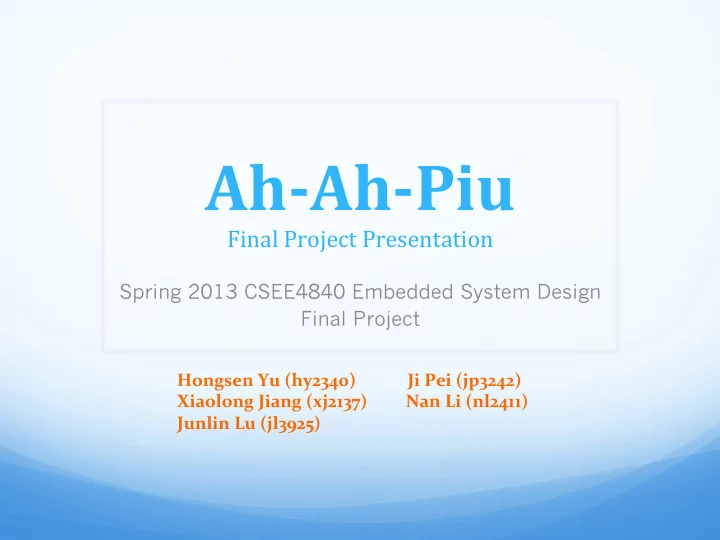

Ah-‑Ah-‑Piu ¡ Final ¡Project ¡Presentation ¡ Spring 2013 CSEE4840 Embedded System Design Final Project Hongsen ¡Yu ¡(hy2340) ¡ ¡ ¡ ¡ ¡ ¡ ¡ ¡ ¡ ¡ ¡ ¡Ji ¡Pei ¡(jp3242) ¡ Xiaolong ¡Jiang ¡(xj2137) ¡ ¡ ¡ ¡ ¡ ¡ ¡ ¡ ¡Nan ¡Li ¡(nl2411) ¡ ¡ ¡ Junlin ¡Lu ¡(jl3925)
Overview ¡ Architecture ¡ Hardware (Audio, ¡VGA ¡& ¡LED, ¡Memory) ¡ Software ¡ Lesson ¡Learned ¡
Description: Ah-‑Ah-‑Piu ¡is ¡a ¡VGA ¡displayed ¡ voice-‑controlled ¡single-‑player ¡platform ¡video ¡ game. ¡ ¡ Game ¡Logic: ¡ The ¡player’s ¡voice ¡captured ¡by ¡ the ¡microphone ¡controls ¡the ¡character ¡in ¡the ¡ game ¡dodging ¡and ¡destroying ¡the ¡incoming ¡ enemies, ¡in ¡order ¡to ¡keep ¡alive ¡as ¡long ¡as ¡ possible ¡and ¡earn ¡more ¡points.
Audio ¡ Wolfson ¡WM8731 ¡Audio ¡Codec ¡ It ¡ is ¡ a ¡ programmable ¡ stereo ¡ Codec ¡ device, ¡ contains ¡ two ¡ pairs ¡of ¡ADC ¡and ¡DAC ¡to ¡accommodate ¡both ¡left ¡and ¡right ¡ channels ¡of ¡stereo ¡audio. ¡ ¡The ¡convertors ¡support ¡16-‑32 ¡bits ¡ resolution ¡ and ¡ 8-‑96 ¡ kHz ¡ sampling ¡ rate. ¡ The ¡ codec ¡ is ¡ programmable ¡via ¡2-‑wire ¡i2c ¡control ¡bus ¡which ¡initialize ¡the ¡ Codec’s ¡11 ¡control ¡registers ¡from ¡the ¡control ¡interface ¡to ¡set ¡ up ¡the ¡chip ¡conTiguration. ¡ ¡And ¡the ¡Codec ¡communicate ¡with ¡ the ¡outside ¡world ¡through ¡the ¡digital ¡audio ¡interface. ¡
WM8731 ¡Audio ¡Codec
Audio ¡ Input: ¡ Capture ¡the ¡player’s ¡voice ¡with ¡ the ¡microphone, ¡transform ¡this ¡signal ¡ into ¡audio ¡sound ¡byte ¡which ¡represent ¡ the ¡magnitude ¡of ¡the ¡sound ¡and ¡provide ¡ it ¡to ¡the ¡software. ¡ Output: ¡ Play ¡the ¡sound ¡effect ¡and ¡ background ¡music ¡from ¡the ¡headphone
Input ¡ The ¡Codec ¡perform ¡the ¡ADC ¡on ¡a ¡8kHz ¡sampling ¡rate ¡ and ¡16 ¡bits ¡resolution. ¡ ¡ ¡ Take ¡the ¡outputted ¡digital ¡data ¡from ¡ADCDAT ¡signal, ¡ use ¡a ¡module ¡to ¡de-‑serialize ¡the ¡raw ¡single-‑bit ¡bit ¡ stream ¡into ¡16 ¡bits ¡.WAV ¡format. ¡ ¡ In ¡the ¡module ¡we ¡spilt ¡external ¡system ¡generated ¡ reference ¡clock ¡(25MHz) ¡to ¡8kHz ¡and ¡128kHz, ¡load ¡ every ¡consecutive ¡16 ¡bits ¡into ¡an ¡array ¡(sound ¡byte) ¡ and ¡with ¡the ¡help ¡of ¡audio ¡controller, ¡write ¡the ¡ sound ¡byte ¡into ¡one ¡address ¡of ¡the ¡register. ¡ ¡
Input ¡ the ¡software ¡read ¡the ¡sound ¡byte ¡from ¡the ¡register, ¡it ¡will ¡ get ¡ an ¡ integer ¡ that ¡ ranging ¡ from ¡ 0 ¡ to ¡ 65,535. ¡ If ¡ the ¡ most ¡ signiTicant ¡bit ¡is ¡0, ¡then ¡the ¡integer ¡ranges ¡from ¡0 ¡to ¡32,767 ¡ represents ¡ increasing ¡ magnitude. ¡ Otherwise, ¡ the ¡ integer ¡ ranges ¡ from ¡ 32,768 ¡ to ¡ 65,535 ¡ in ¡ decreasing ¡ order ¡ of ¡ magnitude. ¡
Audio_out ¡
VGA ¡ 216-‑color ¡Web ¡color ¡map ¡ ¡Save ¡storage ¡space; ¡Maintain ¡high ¡resolution. ¡ ¡ 4 ¡layers ¡ ¡Many ¡elements ¡need ¡separate ¡process. ¡ Separate ¡control ¡of ¡each ¡element ¡ ¡Individual ¡movement ¡controlled ¡by ¡software ¡ ¡
VGA ¡ Communicate ¡ ¡Buffer ¡used ¡in ¡communication ¡with ¡software. ¡ ¡Fetch ¡color ¡map ¡index ¡stored ¡in ¡SRAM. ¡
LED ¡ Directly ¡controlled ¡by ¡processor ¡ ¡Four ¡digitals ¡are ¡written ¡to ¡separate ¡buffer ¡ ¡ ¡ ¡ ¡ ¡ ¡address. ¡ ¡Decode ¡and ¡print ¡digital ¡value. ¡
Memory ¡ ¡allocation 1. ¡ ¡ ¡ ¡On ¡Chip ¡Memory Store ¡the ¡sound ¡effect 2. ¡ ¡ ¡512k ¡SRAM Store ¡image ¡data, ¡using ¡two ¡projects ¡ instead ¡of ¡a ¡MUX 3. ¡ ¡ ¡8M ¡SDRAM Include ¡Pll ¡
Audio ¡Input ¡Categorization ¡ Collision ¡Detection ¡ Game ¡Logic
Hardware ¡ ¡ Audio ¡ Set ¡up ¡the ¡control ¡register ¡using ¡the ¡ de2_i2c_av_conTig.v ¡Tile ¡ ¡ ¡ ¡ ¡ R2, ¡R3: ¡ LHPVOL ¡and ¡RHPVOL ¡Volume ¡ ¡ control; ¡ LZCEN ¡left ¡zero ¡crossing ¡detect ¡ ¡ enable; ¡ ¡ LRHPBOTH ¡left ¡headphone ¡ controlling ¡both ¡channels ¡ ¡ ¡ R4: ¡ ¡ INSEL ¡Input ¡selected ¡ MUTE ¡MIC ¡ ¡ SIDE ¡TONE ¡ ¡ MIC ¡BOOST ¡
Hardware ¡ Audio ¡ ¡ 1. ¡Figure ¡out ¡the ¡clock ¡divider ¡meaning ¡in ¡sample ¡program, ¡and ¡ calculate ¡the ¡proper ¡clock ¡frequency. 2. ¡Do ¡not ¡code ¡the ¡same ¡Tile ¡in ¡two ¡or ¡more ¡programs ¡at ¡the ¡ same ¡time, ¡or ¡you ¡may ¡miss ¡some ¡modiTication. 3. ¡When ¡doing ¡large ¡scale ¡replacing ¡of ¡code, ¡do ¡it ¡in ¡gedit, ¡ rather ¡than ¡in ¡Quartus ¡or ¡Nios2. ¡The ¡latter ¡is ¡much ¡slower, ¡and ¡ may ¡leads ¡to ¡program ¡crash.
Hardware ¡ VGA ¡ DSP ¡for ¡images ¡ • ¡Photoshop ¡to ¡convert ¡216-‑color ¡map ¡image. ¡ ¡Matlab ¡to ¡extract ¡bit ¡data ¡for ¡image. ¡ ¡ Separate ¡layers ¡design ¡ • ¡relieve ¡the ¡work ¡load ¡of ¡process. ¡ ¡reduce ¡compiling ¡time. ¡ ¡ ¡ ¡ ¡ ¡
Hardware ¡ Memory ¡Allocation ¡ • ROM: ¡we ¡should ¡use ¡a ¡.mif ¡Tile ¡to ¡describe ¡the ¡content ¡in ¡ ROM. ¡ • SRAM: ¡Since ¡there ¡are ¡some ¡different ¡matrix ¡in ¡the ¡SRAM, ¡ We ¡have ¡to ¡know ¡the ¡exact ¡address ¡and ¡offset ¡for ¡each ¡data. ¡ • SDRAM: ¡Due ¡to ¡the ¡frequency ¡problem, ¡we ¡have ¡to ¡add ¡a ¡PLL ¡ ¡ core ¡to ¡ ¡unify ¡its ¡clock ¡with ¡NIOS-‑2 ¡CPU. ¡Moreover, ¡the ¡BGM ¡ is ¡also ¡stored ¡in ¡the ¡SDRAM. ¡ ¡ ¡ ¡ We ¡have ¡created ¡a ¡new ¡algorithm ¡to ¡calculate ¡the ¡correct ¡ address ¡from ¡SRAM ¡to ¡VGA. ¡ ¡ ¡ ¡ ¡
Recommend
More recommend